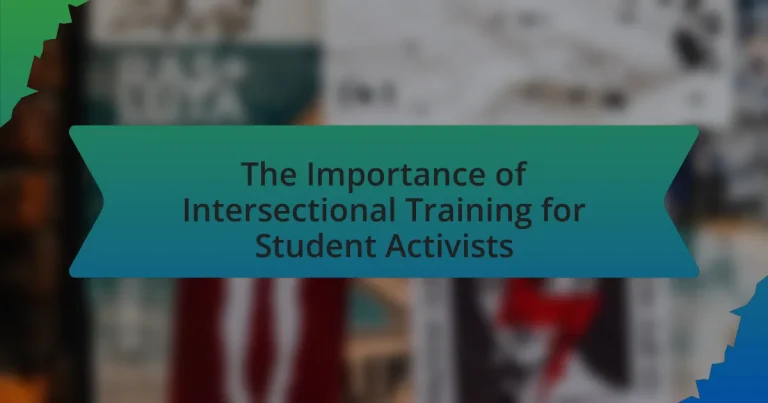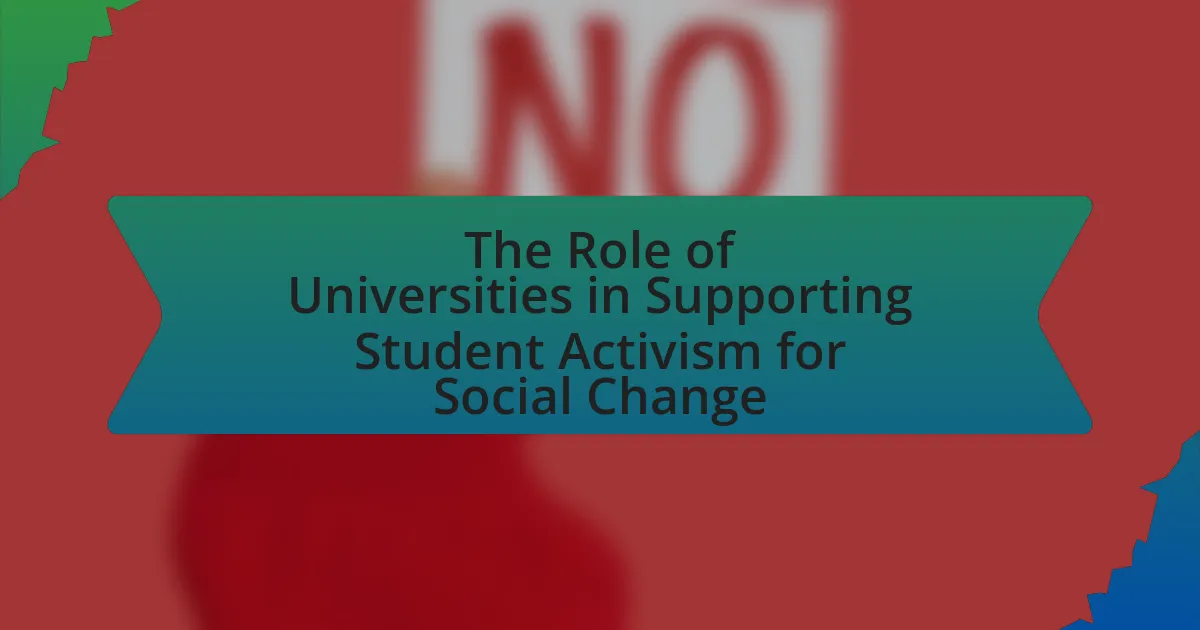The article emphasizes the significance of intersectional training for student activists, highlighting how understanding the interplay of various social identities—such as race, gender, sexuality, and class—can enhance activism effectiveness. It discusses the necessity of recognizing systemic inequalities and the unique experiences of marginalized groups to foster inclusive movements. Key components of intersectional training, including empathy development and actionable advocacy strategies, are outlined, along with the challenges faced by activists lacking this training. The article also explores methods for implementing intersectional training and the long-term benefits it provides, such as improved coalition-building and advocacy skills, ultimately leading to more impactful social change.
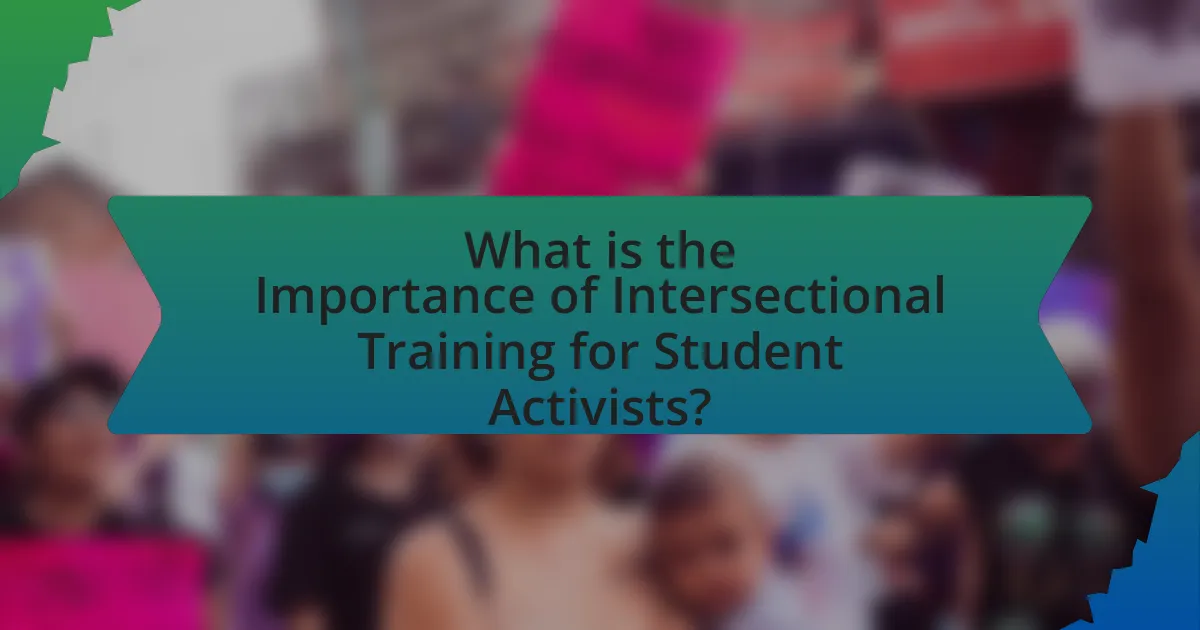
What is the Importance of Intersectional Training for Student Activists?
Intersectional training is crucial for student activists as it equips them with the understanding of how various social identities—such as race, gender, sexuality, and class—intersect to create unique experiences of oppression and privilege. This training fosters a more inclusive and effective activism by encouraging students to recognize and address the diverse needs and perspectives within their communities. Research indicates that movements that embrace intersectionality are more successful in achieving social justice goals, as they can mobilize a broader coalition of support and address systemic inequalities more comprehensively. For example, the 2017 Women’s March highlighted the importance of intersectionality by bringing together diverse groups to advocate for a range of issues, demonstrating that inclusive activism can amplify voices that are often marginalized.
Why is intersectionality crucial in activism?
Intersectionality is crucial in activism because it recognizes that individuals experience overlapping social identities, which can lead to unique forms of discrimination and privilege. This framework allows activists to address the complexities of social justice issues more effectively, ensuring that the needs of marginalized groups are not overlooked. For instance, a study by Crenshaw (1989) highlighted how Black women face discrimination that is distinct from that experienced by white women or Black men, emphasizing the necessity of an intersectional approach to advocate for equitable policies. By incorporating intersectionality, activists can create more inclusive movements that resonate with a broader audience and foster solidarity among diverse groups.
What does intersectionality mean in the context of student activism?
Intersectionality in the context of student activism refers to the understanding that various social identities, such as race, gender, sexuality, and class, intersect to create unique experiences of oppression and privilege. This concept emphasizes that student activists must consider these overlapping identities to effectively address systemic inequalities and advocate for inclusive policies. Research by Kimberlé Crenshaw, who coined the term, highlights how marginalized groups face compounded discrimination, which is crucial for student activists to recognize in their efforts to create equitable environments on campuses.
How does intersectionality influence the effectiveness of activism?
Intersectionality significantly enhances the effectiveness of activism by recognizing and addressing the interconnected nature of social categorizations such as race, gender, and class. This approach allows activists to understand how various forms of discrimination overlap and impact individuals differently, leading to more inclusive and targeted strategies. For instance, research by Crenshaw (1989) highlights that Black women face unique challenges that are not fully addressed by movements focusing solely on race or gender, demonstrating that intersectional awareness can lead to more comprehensive solutions. By incorporating intersectionality, activists can mobilize diverse communities, foster solidarity, and create policies that reflect the complexities of lived experiences, ultimately increasing the impact and reach of their efforts.
What are the key components of intersectional training?
The key components of intersectional training include understanding diverse identities, recognizing systemic inequalities, fostering empathy, and developing actionable strategies for advocacy. Understanding diverse identities involves exploring how race, gender, sexuality, class, and other factors intersect to shape individual experiences. Recognizing systemic inequalities requires analyzing how these identities influence access to resources and opportunities. Fostering empathy encourages participants to appreciate different perspectives and experiences, which is crucial for effective activism. Developing actionable strategies for advocacy equips individuals with the tools to address and challenge inequities in their communities. These components collectively enhance the effectiveness of student activists by promoting a comprehensive approach to social justice.
What topics are covered in intersectional training programs?
Intersectional training programs cover topics such as race, gender, sexuality, class, ability, and other social identities and how they intersect to create unique experiences of privilege and oppression. These programs aim to educate participants on the complexities of social justice issues, emphasizing the importance of understanding multiple identities in advocacy work. Research indicates that effective intersectional training enhances awareness and fosters inclusive practices among activists, leading to more equitable outcomes in social movements.
How do these components enhance activist skills?
Intersectional training components enhance activist skills by providing a comprehensive understanding of diverse social identities and systemic inequalities. This training equips activists with the ability to recognize and address the unique challenges faced by various marginalized groups, fostering more inclusive and effective advocacy strategies. Research indicates that intersectional approaches lead to greater engagement and solidarity among activists, as they learn to appreciate the interconnectedness of different social justice issues, ultimately resulting in more impactful movements.
What challenges do student activists face without intersectional training?
Student activists face significant challenges without intersectional training, primarily the inability to address the diverse needs and experiences of marginalized groups effectively. This lack of training can lead to the perpetuation of systemic inequalities within activist movements, as activists may overlook critical issues related to race, gender, sexuality, and class. For instance, research by Crenshaw (1989) highlights how failing to consider intersectionality can result in advocacy that does not resonate with or support all community members, ultimately weakening the movement’s impact. Additionally, without intersectional training, student activists may struggle to build coalitions, as they might inadvertently alienate potential allies who feel their specific concerns are not acknowledged or prioritized.
How can lack of intersectional awareness lead to ineffective activism?
Lack of intersectional awareness can lead to ineffective activism by failing to address the diverse and overlapping identities and experiences of marginalized groups. When activists do not consider how factors such as race, gender, sexuality, and socioeconomic status intersect, their efforts may overlook the specific needs and challenges faced by these groups. For instance, a study by Crenshaw (1989) highlighted how Black women experience discrimination differently than either Black men or white women, illustrating that a one-size-fits-all approach to activism can alienate those who do not fit neatly into singular categories. Consequently, this oversight can result in policies and initiatives that do not adequately support or empower the very communities activists aim to help, ultimately diminishing the effectiveness and reach of their movements.
What are the consequences of ignoring intersectionality in social movements?
Ignoring intersectionality in social movements leads to the marginalization of specific groups and the perpetuation of systemic inequalities. When social movements fail to consider the diverse identities and experiences of individuals, they risk alienating those who do not fit into the dominant narrative, which can result in a lack of representation and voice for marginalized communities. For instance, the Women’s March in 2017 faced criticism for not adequately addressing the needs of women of color and individuals, highlighting how exclusion can weaken the movement’s overall impact and solidarity. Additionally, research by the American Psychological Association indicates that movements lacking an intersectional approach may struggle to achieve their goals, as they overlook the interconnected nature of social identities and the unique challenges faced by different groups.
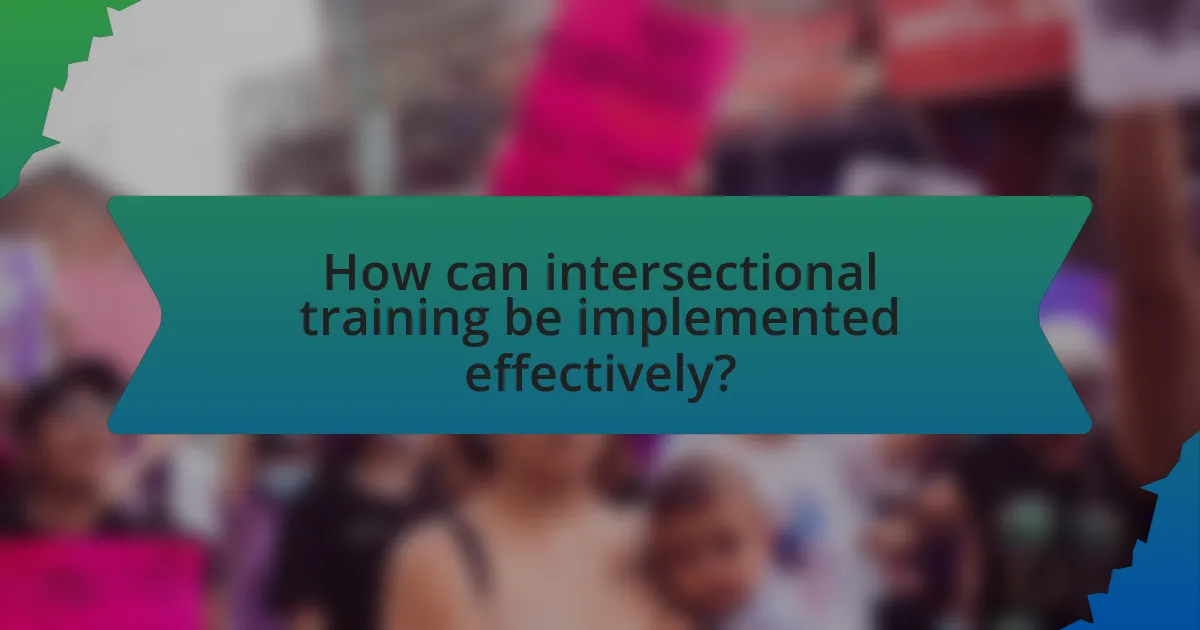
How can intersectional training be implemented effectively?
Intersectional training can be implemented effectively by integrating diverse perspectives into the curriculum and fostering an inclusive environment. This involves actively engaging participants in discussions that highlight the interconnectedness of various social identities, such as race, gender, and socioeconomic status. Research indicates that programs incorporating experiential learning, such as workshops and role-playing scenarios, enhance understanding and empathy among participants. For instance, a study by Crenshaw (1989) emphasizes the necessity of recognizing overlapping identities to address systemic inequalities. By utilizing these methods, organizations can create a more comprehensive and impactful intersectional training experience.
What methods are used to deliver intersectional training?
Intersectional training is delivered through various methods including workshops, seminars, online courses, and experiential learning activities. Workshops often involve interactive discussions and group activities that encourage participants to explore their own identities and understand the complexities of intersectionality. Seminars typically feature expert speakers who provide insights and research findings on intersectional issues. Online courses offer flexible learning opportunities with multimedia resources, allowing participants to engage with the material at their own pace. Experiential learning activities, such as role-playing or community engagement projects, help participants apply intersectional concepts in real-world contexts. These methods collectively enhance understanding and promote critical thinking about the interconnectedness of social identities and systemic inequalities.
How do workshops and seminars facilitate understanding of intersectionality?
Workshops and seminars facilitate understanding of intersectionality by providing interactive platforms for participants to engage with diverse perspectives and experiences. These educational settings encourage dialogue and critical thinking, allowing individuals to explore how various social identities—such as race, gender, class, and sexuality—intersect and impact people’s lives. Research indicates that experiential learning, such as role-playing and group discussions, enhances comprehension of complex social issues, making the concept of intersectionality more relatable and applicable. For instance, a study by Crenshaw (1989) highlights how intersectionality can illuminate the unique challenges faced by individuals at the crossroads of multiple marginalized identities, reinforcing the necessity of inclusive training for effective activism.
What role do peer discussions play in intersectional training?
Peer discussions play a crucial role in intersectional training by facilitating the exchange of diverse perspectives and experiences among participants. This collaborative dialogue enhances understanding of complex social identities and systemic inequalities, allowing individuals to critically engage with intersectionality. Research indicates that peer discussions promote empathy and awareness, as participants share personal narratives that highlight the interconnectedness of various forms of oppression. For instance, a study published in the Journal of Social Issues found that group discussions significantly improved participants’ ability to recognize and analyze intersectional issues, leading to more informed activism. Thus, peer discussions are essential for deepening the impact of intersectional training among student activists.
What resources are available for student activists seeking intersectional training?
Student activists seeking intersectional training can access various resources, including workshops, online courses, and literature focused on intersectionality. Organizations such as the Intersectional Justice Project and the Center for Intersectional Justice offer training programs that emphasize the importance of understanding how different social identities intersect and impact activism. Additionally, platforms like Coursera and edX provide courses on social justice and intersectionality, often developed by reputable universities. Academic texts, such as “Intersectionality” by Kimberlé Crenshaw, serve as foundational literature that outlines the principles of intersectional theory and its application in activism. These resources collectively equip student activists with the knowledge and skills necessary to engage in effective and inclusive advocacy.
Which organizations provide intersectional training programs?
Organizations that provide intersectional training programs include the National Task Force, Race Forward, and the Women’s March. The National Task Force offers training focused on issues within various social justice contexts. Race Forward specializes in racial justice and provides resources and training that emphasize intersectionality in addressing systemic inequalities. The Women’s March focuses on women’s rights and incorporates intersectional perspectives in its training initiatives to empower activists. These organizations are recognized for their commitment to fostering an understanding of how various social identities intersect and impact experiences of oppression and privilege.
How can online platforms enhance access to intersectional training?
Online platforms can enhance access to intersectional training by providing flexible, scalable, and diverse learning environments. These platforms enable learners from various backgrounds to engage with content that addresses multiple identities and experiences, fostering a more inclusive educational experience. For instance, research by the Pew Research Center indicates that 73% of adults believe online learning can be as effective as traditional classroom learning, which supports the idea that online platforms can effectively deliver intersectional training. Additionally, the use of multimedia resources, such as videos, podcasts, and interactive forums, allows for varied learning styles and promotes deeper understanding of complex intersectional issues.
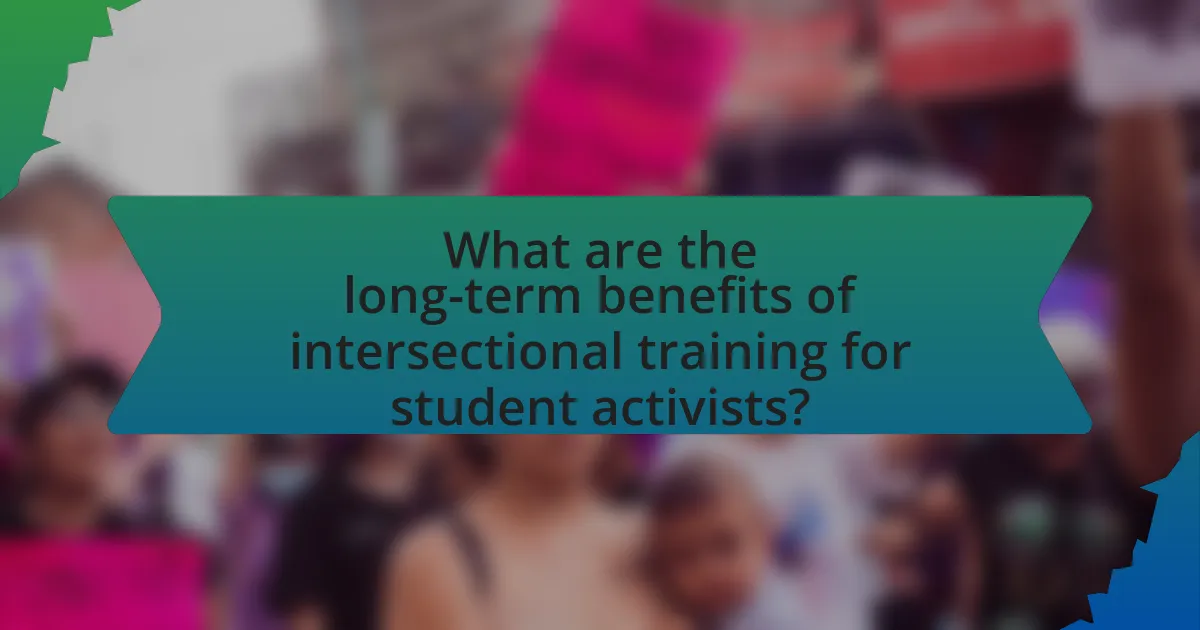
What are the long-term benefits of intersectional training for student activists?
Intersectional training for student activists provides long-term benefits such as enhanced advocacy skills, improved coalition-building, and a deeper understanding of systemic inequalities. These benefits empower student activists to address complex social issues more effectively. Research indicates that activists trained in intersectionality are better equipped to engage diverse communities, as they recognize the interconnectedness of various forms of oppression, leading to more inclusive and impactful movements. For instance, a study by Crenshaw (2017) highlights that intersectional approaches in activism foster solidarity among marginalized groups, ultimately resulting in more sustainable social change.
How does intersectional training foster inclusive activism?
Intersectional training fosters inclusive activism by equipping activists with the understanding of how various social identities intersect to create unique experiences of oppression and privilege. This training emphasizes the importance of recognizing and addressing the diverse needs and perspectives within marginalized communities, thereby promoting solidarity and collaboration among activists. Research indicates that inclusive activism, which incorporates intersectional perspectives, leads to more effective advocacy by ensuring that all voices are heard and represented, ultimately resulting in more comprehensive and sustainable social change. For instance, a study by Crenshaw (1989) highlights how intersectionality can illuminate the complexities of discrimination faced by individuals at the intersections of race, gender, and class, reinforcing the necessity of inclusive approaches in activism.
What impact does inclusive activism have on community engagement?
Inclusive activism significantly enhances community engagement by fostering a sense of belonging and representation among diverse groups. This approach encourages participation from marginalized communities, leading to a more comprehensive understanding of local issues and needs. Research indicates that inclusive activism can increase volunteerism by 30% in communities where diverse voices are actively sought and valued, as seen in studies conducted by the Stanford Social Innovation Review. By integrating various perspectives, inclusive activism not only strengthens community ties but also promotes collaborative problem-solving, ultimately resulting in more effective and sustainable community initiatives.
How can inclusive activism lead to broader social change?
Inclusive activism can lead to broader social change by fostering a diverse coalition that amplifies marginalized voices and addresses systemic inequalities. This approach encourages collaboration among various social justice movements, creating a unified front that can challenge entrenched power structures more effectively. Research indicates that movements incorporating intersectional perspectives, such as the Black Lives Matter movement, have successfully mobilized diverse groups, resulting in significant policy changes and increased public awareness about issues like racial injustice and police reform. By prioritizing inclusivity, activism not only broadens its reach but also enhances its impact, as evidenced by the growing support for comprehensive social policies that address multiple forms of discrimination.
What skills do student activists gain from intersectional training?
Student activists gain critical skills such as enhanced empathy, effective communication, and strategic thinking from intersectional training. This training fosters an understanding of how various social identities intersect, enabling activists to advocate more inclusively and effectively for diverse communities. Research indicates that intersectional approaches improve coalition-building skills, as activists learn to navigate complex social dynamics and address multiple forms of oppression simultaneously. For example, a study by Crenshaw (1989) highlights how intersectionality can illuminate the unique challenges faced by individuals at the crossroads of various identities, thus equipping activists with the tools to create more equitable social movements.
How does intersectional training improve communication skills?
Intersectional training improves communication skills by fostering an understanding of diverse perspectives and experiences. This training equips individuals with the ability to recognize and navigate the complexities of identity, which enhances empathy and active listening. Research indicates that effective communication is significantly influenced by the awareness of social dynamics; for instance, a study published in the Journal of Communication found that individuals who engage in intersectional training demonstrate improved interpersonal skills and conflict resolution abilities. By integrating these insights, participants can communicate more effectively across various social contexts, leading to more inclusive and productive dialogues.
What leadership qualities are developed through intersectional training?
Intersectional training develops leadership qualities such as empathy, adaptability, and inclusivity. Empathy is cultivated as individuals learn to understand diverse perspectives and experiences, fostering a deeper connection with others. Adaptability emerges from navigating complex social dynamics and responding effectively to various challenges. Inclusivity is reinforced as leaders learn to create environments that value and respect all voices, which is essential for effective collaboration. These qualities are critical for student activists, enabling them to advocate for social justice and equity in a multifaceted society.
What best practices should student activists follow when engaging in intersectional training?
Student activists should prioritize inclusivity, active listening, and continuous education when engaging in intersectional training. Inclusivity ensures that diverse voices and experiences are represented, fostering a comprehensive understanding of various social identities. Active listening allows participants to fully grasp the perspectives of others, which is essential for meaningful dialogue and collaboration. Continuous education involves staying informed about intersectional issues and adapting training methods to reflect current social dynamics. Research indicates that effective intersectional training enhances group cohesion and activism outcomes, as seen in studies conducted by the American Psychological Association, which highlight the positive impact of inclusive practices on social movements.
